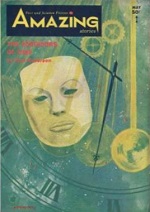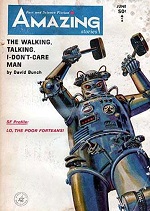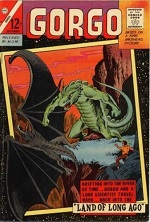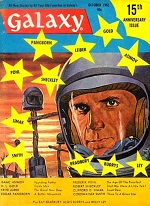|  
 
 
 
 
 
 
 | | | | 



| | The Corridors of Time
by Poul Anderson
First publication: Amazing, May-Jun 1965

While awaiting trial for a self-defense killing, young Malcolm Lockridge is approached by a wealthy beauty, Storm Darroway, who offers to defend him in return for him joining her in what he eventually finds out are Wars in Time between the naturalist Wardens and the technocrat Rangers.

For many years, I thought this novel was part of Poul’s Time Patrol series, until Bob Hasse mentioned this as one of his favorites that is not in the series. The beginning reminded me of Heinlein’s Glory Road, and the rest is remniscent of Asimov’s The End of Eternity, both of which captivated me in the summer of 1968. Poul’s book holds up well in that company. A series of parallel black lines, several inches apart, extended from it, some distance across the corridor floor. At the head of each was a brief inscription, in no alphabet he could recognize. But every ten feet or so a number was added. He saw 4950, 4951, 4952 . . . A series of parallel black lines, several inches apart, extended from it, some distance across the corridor floor. At the head of each was a brief inscription, in no alphabet he could recognize. But every ten feet or so a number was added. He saw 4950, 4951, 4952 . . . 
| |
| | | | |

 
 | | | | 

| | Gorgo
by Joe Gill, Steve Ditko, Dick Giordano and ROcco Mastroserio
First time travel: Gorgo 23, Sep 1965

I don’t know which was conceived first: the movie version of Gorgo giant-monster-from-the-sea (who turns out to be a baby) or the comic book version, but the comic book version from Charlton first appeared in December 1959, whereas the movie wasn’t released until 1961. More importantly, however, the final issue of the comic (Gorgo 23, Sep 1965) has time travel when Dr. Hobart Howarth rescues Gorgo from an evil Pentagon attack by sending the giant lizard back to the late Jurassic.
 Sadly, as a child, I bought only one Gorgo comic, which was not the time-travel issue, but the stories are definitely drawn by Steve Ditko, hooray! Sadly, as a child, I bought only one Gorgo comic, which was not the time-travel issue, but the stories are definitely drawn by Steve Ditko, hooray! I, Senator Sam Brockton tell you this, my fellow citizens, the great danger to our world isn’t communism it is Gorgo and the female that spawned him! I, Senator Sam Brockton tell you this, my fellow citizens, the great danger to our world isn’t communism it is Gorgo and the female that spawned him! 

—Gorgo 16
| |
| | | | |

 | | | | 

| | I Dream of Jeannie
created by Sidney Sheldon
First time travel: 25 Sep 1965

Five seasons with 3 time-travel episodes, all with Jeannie (who was the primary reason I wanted to be an astronaut).

Naturally, I never had any refined taste (as indicated by the Bronze Eloi Medal awarded tp Jeannie), but I was a product of my 60s childhood, and, besides, Jeannie (occassionly and briefly) had a belly button (including Season 5’s “Mrs. Djinn-Djinn”).- My Hero? (25 Sep 1965) to ancient Babylon
- My Master, the Pirate (13 Mar 1967) to Captain Kidd’s time
- My Master, Napoleon’s Buddy (3 Apr 1967) to Napoleaon's time
 We’re at the marketplace, master. Oh, and there is Ali, the man who hit me. We’re at the marketplace, master. Oh, and there is Ali, the man who hit me. 

—from “My Hero?”
| |
| | | | |

 | | | | 

 The story also appeared in this paperback of Simak stories with a beautiful Eddie Jones cover, which I bought in Scotland at Christmas break in 1977. The story also appeared in this paperback of Simak stories with a beautiful Eddie Jones cover, which I bought in Scotland at Christmas break in 1977. | | “Small Deer”
by Clifford D. Simak
First publication: Galaxy, Oct 1965

Alton James has a bent for all things mechanical and an interest in dinosaurs, so when his mathematically minded friend describes how a time machine should be built, Alton builds it and heads for 65 million B.C. to see what killed off the dinosaurs. We were lucky, that was all. We could have sent that camera back another thousand times, perhaps, and never caught a mastodon—probably never caught a thing. Although we would have known it had moved in time, for the landscape had been different, although not a great deal different. But from the landscape we could not have told if it had gone back a hundred or a thousand years. When we saw the mastadon, however, we knew we’d sent the camera back 10,000 years at least. We were lucky, that was all. We could have sent that camera back another thousand times, perhaps, and never caught a mastodon—probably never caught a thing. Although we would have known it had moved in time, for the landscape had been different, although not a great deal different. But from the landscape we could not have told if it had gone back a hundred or a thousand years. When we saw the mastadon, however, we knew we’d sent the camera back 10,000 years at least.
 I won’t bore you with how we worked out a lot of problems on our second model, or how Dennis managed to work out a time-meter that we could calibrate to send the machine a specific distance into time. Because all this is not important. What is important is what I found when I went into time. I won’t bore you with how we worked out a lot of problems on our second model, or how Dennis managed to work out a time-meter that we could calibrate to send the machine a specific distance into time. Because all this is not important. What is important is what I found when I went into time.
 I’ve already told you I’d read your book about Cretaceous dinosaurs and I liked the entire book, but that final chapter about the extinction of the dinosaurs is the one that really got me. Many a time I’d lie awake at night thinking about all the theories you wrote about and trying to figure out in my own mind how it really was. I’ve already told you I’d read your book about Cretaceous dinosaurs and I liked the entire book, but that final chapter about the extinction of the dinosaurs is the one that really got me. Many a time I’d lie awake at night thinking about all the theories you wrote about and trying to figure out in my own mind how it really was.
 So when it was time to get into that machine and go, I knew where I would be headed. So when it was time to get into that machine and go, I knew where I would be headed. 
| |
| | | | |

 | | | |  | | 時をかける少女
English title: The Girl Who Leapt Through Time (translated from Japanese)
by Yasutaka Tsutsui (David Karashima, translator)
First publication: Chu̅aku Sannen, Nov 1965 — Taka Ichi, May 1966

 After an earthquake and a fire keep her up late, junior high school girl Kazuko Yoshiyama rushes late to school with her friend Goro, and they both are run down by a speeding truck, but then she finds herself waking up again in a seemingly ordinary morning with no last-night earthquake, no last-night fire, and no runaway truck—at least not at this moment. After an earthquake and a fire keep her up late, junior high school girl Kazuko Yoshiyama rushes late to school with her friend Goro, and they both are run down by a speeding truck, but then she finds herself waking up again in a seemingly ordinary morning with no last-night earthquake, no last-night fire, and no runaway truck—at least not at this moment. As the first period of math class began, Mr. Komatsu—the fat math teacher—wrote down an equation on the board, and Kazuko began to frown. It was the very same problem they’d solved just the day before. But more than that, Mr. Komatsu had written the problem on the board at exactly the same time before, and Kazuko had been called to the front of the class, where she’d struggled for some time over the solution. As the first period of math class began, Mr. Komatsu—the fat math teacher—wrote down an equation on the board, and Kazuko began to frown. It was the very same problem they’d solved just the day before. But more than that, Mr. Komatsu had written the problem on the board at exactly the same time before, and Kazuko had been called to the front of the class, where she’d struggled for some time over the solution. 
| |
| | | | |

No Time Travel. Move along. |
The Other Side of Time by Keith Laumer, Fantastic, Apr 1965 [alternate timelines ]

“Of Time and the Yan” by Roger Zelazny, F&SF, Jun 1965 [despite title, no time travel ]

“Down Styphon!” by H. Beam Piper (paratime), Analog, Nov 1965 [alternate timelines ]

| |     |